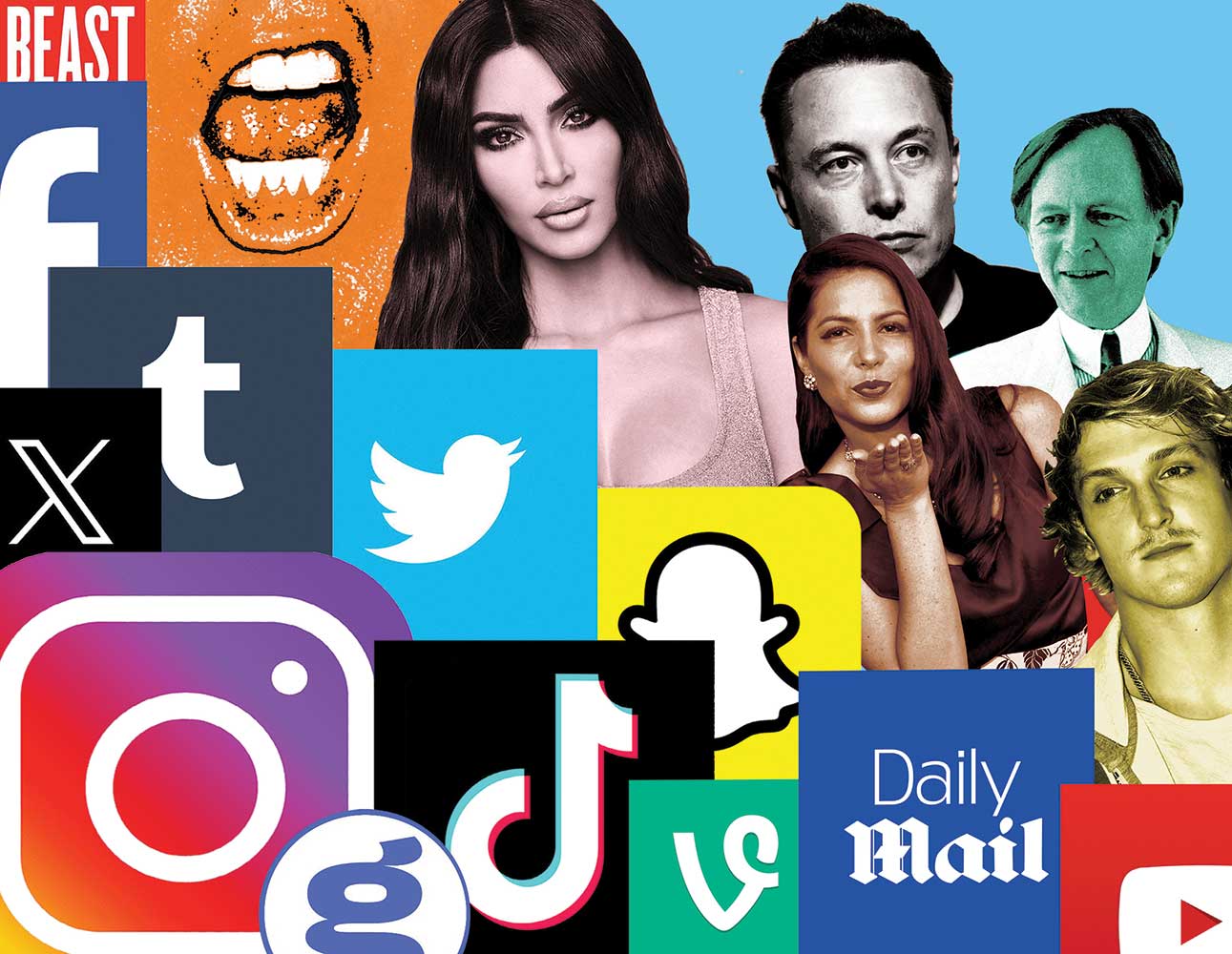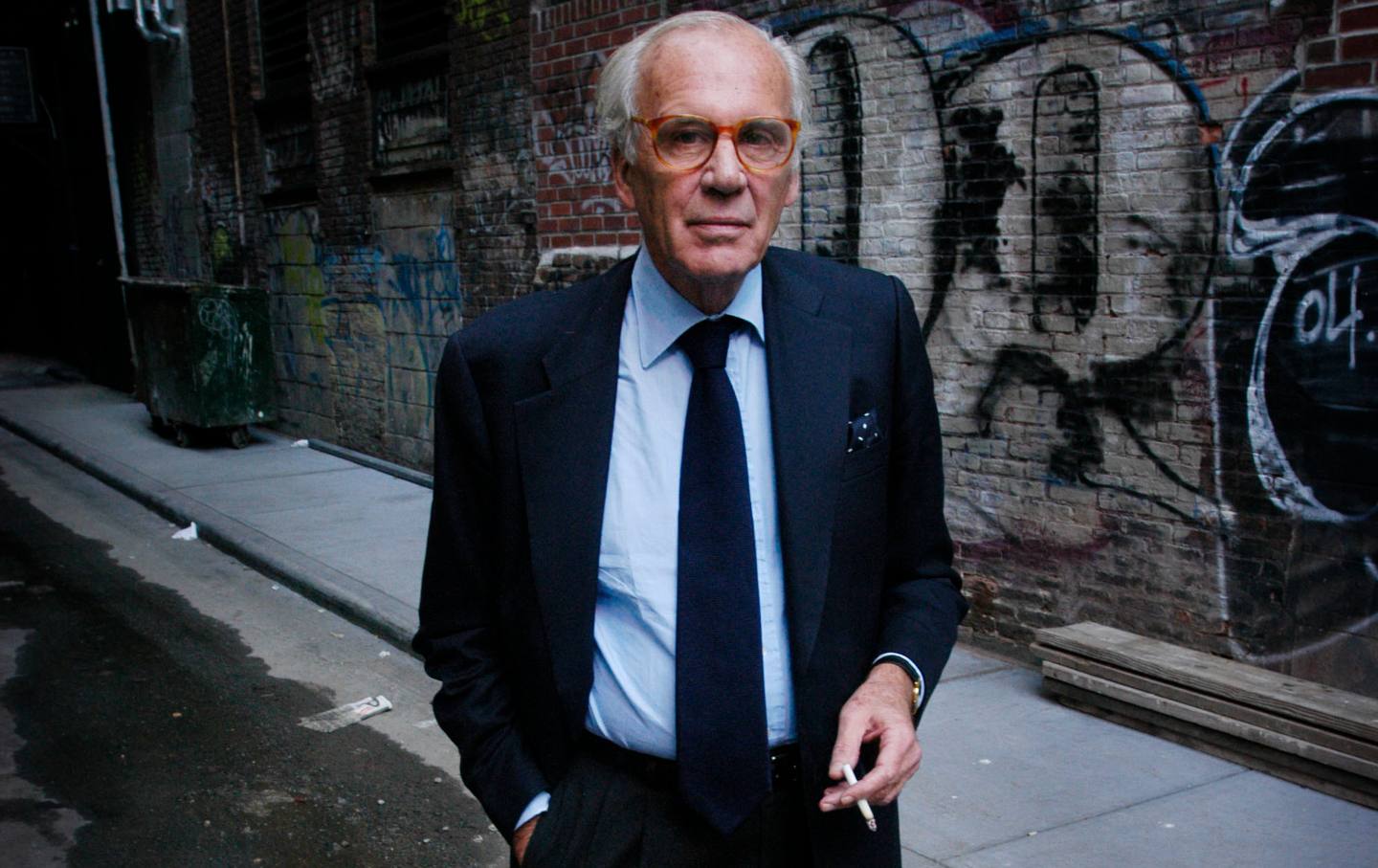Going Viral
Influence and the rise of digital celebrity.
Influence and the Rise of Digital Celebrity
A history of social media from the perspective of the poster, Taylor Lorenz’s Extremely Online examines the roots and rise of our sponsorship-saturated ecosystem.

If there are professions more prone to navel-gazing and backbiting than journalism, they at least have the good sense not to broadcast it. Journalists are congenitally meddlesome, especially when it comes to their own. Yet few writers have exercised the news industry’s gossip muscle more than Taylor Lorenz. Over the past five years, she has established herself as a prolific and able tech reporter, covering everything from Emma Chamberlain and Elon Musk to the ethics of taking selfies at Chernobyl. But every few months, she seems to become a story almost as omnipresent as the Internet personalities she covers.
Books in review
Extremely Online: The Untold Story of Fame, Influence, and Power on the Internet
Buy this bookTwo years ago, when Lorenz left The New York Times for The Washington Post, her departure set off both a Twitter storm and a news storm. In an Insider article, Lorenz cited the limits that the Times places on its reporters’ side projects as one reason for leaving. “Younger people recognize the power of having their own brand,” she explained. “The longer you stay at a job that restricts you from outside opportunities, the less relevant your brand becomes.” Many readers likely breezed by this observation: It wasn’t as if Lorenz was the first journalist to see herself as a brand or leverage it for extra money. The Times itself was rife with reporters who had converted their highly calculated public profiles into lucrative book and movie deals. The White House reporter Maggie Haberman was promoting her opus on the Trump years, while Jodi Kantor and Megan Twohey’s best-selling book on Harvey Weinstein was being adapted into the biodrama She Said. But Lorenz’s comments did incense both her future coworkers and several former ones. A Post writer called her quotes “cringey”; a Times writer said the piece made him “want to dig a giant hole and crawl into it.” Haberman herself weighed in: “Is there something going on in the world other than the desire of some folks to get more attention?” The critics had a point—though by airing it on Twitter, they had also proved Lorenz’s. “Maggie, the attention economy is my entire beat, it’s what I cover,” she tweeted back at Haberman, “and you’re certainly an expert at leveraging it yourself.”
The episode, surely inane and confounding to anyone outside the media, touched an open wound for writers of both Haberman’s and Lorenz’s generations: As the news business has shrunk over the past 20 years, the work traditionally done by legacy institutions—building an audience, securing funding, promoting pieces—has fallen to the writers themselves. “To be a writer today,” as Allegra Hobbs wrote several years ago, “is to make yourself a product for public consumption on the internet.”
The subject of self-commodification sits at the center of Lorenz’s new book, Extremely Online. A history of social media from the perspective of the poster rather than the tech executive, it sketches the genesis of our sponsorship-saturated ecosystem, outlining the early days of platforms from YouTube, Facebook, and Tumblr to Twitter, Instagram, Vine, and TikTok. The book follows the movement of ad dollars away from legacy media outlets toward new platforms, where popular accounts jockeyed for a piece of the profits while the platforms negotiated over how to pay them. Like most of Lorenz’s work, Extremely Online is written almost entirely in the third person. (“I never put the word ‘I’ in any of my stories,” she told an interviewer. “I’d rather die.”) But the book also serves as a chronicle of online life during the past 15 years, a time when Lorenz was fully immersed in it—first as a participant, then as a strategist, then as a reporter, and eventually as all three. To that end, Extremely Online is subtly personal in that it offers the most complete rendering of both Lorenz’s approach to the creator economy and her critique of the old media that it has all but replaced. At times, it reads like Lorenz’s response to reporters like Haberman: her account of how the Internet became a billboard and almost everyone on it a brand.
Before Lorenz started writing about online posters, she was a prolific one herself. In the late aughts, just after she left college, she got into a then-nascent Tumblr, where she eventually started about 80 blogs. Then as now, Lorenz was attentive to online trends. At the time, many Tumblrs were styled after popular templates, like “Fuck Yeah, ___”—a phrase popularized by the Team America song “America, Fuck Yeah,” which Tumblr users repurposed for single-theme sites like “Fuck Yeah, Menswear,” “Fuck Yeah, Pizza,” and “Fuck Yeah, Leonard Nimoy.” Lorenz started one devoted to bagels. Some of her other blogs were more singular, such as “All the Singular Ladies,” where she reblogged news about the Singularity and Beyoncé.
Lorenz’s blogs on Tumblr led to more gainful employment in the field of social media strategy. Beginning in the late aughts, she worked a range of online jobs. She wrote LinkedIn #grindset posts for a for-profit education CEO. She tweeted for a condiment company and ran the socials for brands ranging from Flintstones Vitamins to Verizon (she wisely helped persuade the latter not to include its logo in a 9/11 tribute post). In 2011, she became the social media editor at the Daily Mail, where she registered its first Facebook page, increased its Twitter following more than thirtyfold in months, and helped it sign an early deal with Snapchat Discover. Her previous jobs had been more behind-the-scenes, but at the Daily Mail Lorenz occasionally took the stage. She had a Snapchat Discover show, and in 2014, Politico interviewed her about social media strategy.
While working on the social side of media, Lorenz often felt that reporters in traditional media dismissed both the social platforms more broadly and the kind of digital strategy she did. “People would write these snarky articles,” she told an interviewer last year. “And I was like, these are actually cool people doing cool stuff on the internet and no one’s writing about it from that point of view.” When she switched sides, that outlook shaped her reporting. She approached the rise of social media less as a story about start-ups and tech executives than one about the people and subcultures that populated them. She took seriously trends that others might dismiss as vapid—seeing, say, a crop of themed meme accounts not as a passing teenage fad but as a symptom of evolving online norms. At the same time, her coverage often doubled as a kind of defense, a way to correct the record about what she felt the legacy media had gotten wrong (one headline read: “It’s 2018 and Not Cool to Hate on Creators”). Perhaps above all, Lorenz became best known for getting scoops. At The Daily Beast, she uncovered a trove of secret data on Snapchat. At the Times, she got the inside story on the collapse of the popular Barstool Sports podcast Call Her Daddy. At The Washington Post, she unmasked the right-wing troll behind the anti-trans account Libs of TikTok. And those are just a few. Lorenz’s consistent delivery of scoops made her a regular feature above the fold, on cable news, and on the very platforms she covered.
The proximity of those scoops to fringe poles of the Internet also made her a magnet for online outrage, much of it openly misogynistic or barely masked professional jealousy. One approach to online harassment is to ignore it: mute, block, and move on. But Lorenz, adept at digital strategy, knows that big personalities, frequent posts, and online feuds fuel engagement, the currency of the attention economy—in her book, she calls gossip the “lifeblood of the creator universe.” So the Lorenz outrage cycles often lasted longer than they otherwise might have, in part because she consistently posted through them. “She often reposts and responds to the ridicule she receives, further amplifying the conversation,” the journalist Annie Goldsmith noted on the tech website The Information. The result was that Lorenz became precisely the kind of public figure she would write about: a bogeyman of harassment-inducing proportions on the right; an object of mockery among Glenn Greenwaldian reactionaries; a quasi-martyr among the liberals who rushed to defend her against Fox News; and a source of irritation among the media upper class, which sees her work as somehow gauche, as well as the numerous indifferent who simply see too many of her posts.
Unlike most of Lorenz’s reporting, Extremely Online is not a vessel for scoops so much as a synthesis of the work she’s already done. As Lorenz sees it, conventional narratives about social media’s rise give too much credit to “the massive corporations, the founders behind them, their visionary innovations, and the power they wield.” The real pioneers of online culture, Lorenz argues, were not the Silicon Valley kingpins but the users themselves. The open infrastructure of the Internet allowed ordinary people to reach a level of renown once reserved for politicians or Hollywood starlets. These newly empowered posters not only shaped the norms of the social media sites they used; they influenced their very infrastructure, as in Twitter’s “retweet” feature, an ad hoc invention pioneered by posters before it was built into the site. But to Lorenz, the greatest change those users wrought concerned how tech companies engaged with ads. As influencing became professionalized, she argues, it was the creators who figured out how to become brands by selling themselves and then forcing the tech companies to let them profit.
Self-commodification online, in Lorenz’s telling, began before contemporary social media. In the mid-1990s, consumers of the Internet began to stumble across “web logs,” self-run sites where anyone could share links or journal about their lives. By the early aughts, these web logs had morphed into blogs: wonky political outlets like Talking Points Memo or the Drudge Report; street photographers like Bryan Boy and The Sartorialist’s Scott Schuman, who upended Fashion Week hierarchies with coverage of quotidian fashion; and gossip sites like Perez Hilton and Gawker, which broke news about both conventional celebrities and the burgeoning new online kinds.
Discounted at first by professional journalists, this new media underclass soon scored enough readers not only to sell ads but to spawn entire companies devoted to brokering sales on their behalf. The defining figures of this moment, Lorenz argues, were the “mommy bloggers”—mothers who candidly narrated their struggles raising children and cultivated massive readerships in the process. The model for contemporary influencer culture, Lorenz contends, was first innovated by the mommy bloggers: They created online personas, grew huge audiences (and attracted online hate), and converted all this attention into ad and affiliate-link income. By the end of the aughts, one Nielsen study found, a fifth of the online population was made up of “women between the ages of 25 and 54 with at least one child.” Advertisers paid attention. “For the top class of mommy bloggers,” Lorenz writes, “the windfall brought in by ads and sponsored content was astonishing.”
Blogging was a kind of social media: Blogs were often in conversation with one another and operated comment sections that resembled forums. But as social media, as we have come to know it—first with Friendster and Myspace; then with Facebook, YouTube, and Twitter; then with Snapchat, Instagram, and TikTok—began to take over, the online economy found new ways to commodify digital celebrity and the engagement it generated. And it was Julia Allison, a popular Tumblr user, whom Lorenz credits with being the first of these new social media “influencers.”
Allison was a former blogger, an aughts personality who, like Paris Hilton and Kim Kardashian, became known for being known. Unlike those stars, who were born with connections, Allison did not start off with clout in the conventional world. Instead, she pursued it: Branding herself as the second coming of Sex and the City’s Carrie Bradshaw, she documented her life on blogs and in a dating column before migrating to Tumblr in 2007. Much of early Web discourse was a negotiation over which puns would make it into the lexicon, and Allison was associated with many of the mid-aughts neologisms—an organizer at the “Webutante Ball” (an event similar to “ROFLCon” and KnowYourMeme’s “A Night to ReMEMEber”), dubbed an early “ceWEBbrity” and the less-catchy “Tumblrebrity.” Soon she was also a feature of the New York media scene and a regular antagonist of sites like Gawker (full disclosure: I used to work for the Gawker reboot). To some extent, one can see Allison as a surrogate for Lorenz herself: a Tumblr power user who had broken out; who endured a torrent of undue harassment; who both courted and feuded with the media—and whose profile rose in proportion with those feuds; and who saw online engagement as a game that could be won. Early in Allison’s career, she saw Tom Wolfe on a book tour and had an epiphany. “Everywhere he went, he appeared in his iconic white suit,” Lorenz writes. “‘He’s a brand,’ [Allison] realized. ‘I’ve got to be known and become a name.’”
Like Lorenz, Allison also attracted abuse at the hands of the very audience she sought (“INTERNET fame-whore Julia Allison is no feminist,” read one Page Sixitem). But to see her purely as a casualty of a sexist press misses some of the story. Also like Lorenz, Allison was a virtuosic self-publicist. Embracing controversy, she understood that her combative relationship with digital media was the key to both her star power and her ability to get paid for what she did. Gawker covered her after she pulled an arch stunt: crashing one of founder Nick Denton’s parties in a dress made from condoms. When the site was cruel to her, as it often was, she turned it to her advantage—inviting the staff to her birthday, e-mailing them with tips, once joining the site to liveblog. The attention of the Internet, of course, can brutalize even those who are best at directing it, and by 2012 Allison had quit public life. But even then, she managed to stay somewhat in control: She deleted her sites, scrubbed her socials, flooded her critics with cease-and-desist letters, and started over in a field she knew well—media relations.
Lorenz uses Allison’s story as a template to explain the subsequent rise of online influencing: how regular people gamified social media clout and converted it into income, often despite the hindrances of the platforms they used. Allison initially struggled to make money from her fame. The infrastructure of Tumblr didn’t make it easy for users to monetize their blogs; the platform did not disclose follower counts, and so advertisers could not quantify anyone’s particular “influence.” Many of the first wave of social media platforms had similar limitations: Facebook, which tried to re-create the connections of the real world, at first capped the number of “friends” any given user could have. Instagram, where anyone could subscribe to public accounts, allowed for a more porous kind of interaction, though one in which self-branding and ad partnerships were initially discouraged. But Allison pioneered a workaround. She garnered celebrity on Tumblr and then found ways to reap revenue from it: She appeared in commercials; starred in a reality series; and raised seed money to launch a company called NonSociety, which functioned, Lorenz writes, like an “early version of a collab house.”
Popular
“swipe left below to view more authors”Swipe →The problem that Allison and her peers faced was essentially a compensation issue, Lorenz argues. Members of the so-called “new media,” they created “content” for public consumption—content that benefited the tech platforms they used but whose profits they did not necessarily receive. To make a career out of posting, they had to monetize their personalities and turn their online celebrity into something for sale as well. But the logistical task of converting persona into product was not always straightforward. Its omnipresence today is the result of years of internecine negotiations over sponsorship strategies, regular battles between social media platforms and influencers, and a byzantine network of advertising models that emerged to profit from the new media’s stars. Lorenz, who devotes a chapter to each of the major social media platforms, examines how the sites sought to channel the new content to their benefit and how the content creators in turn came up with new models to redirect some of the profits their way.
The 2010s brought a gold rush for users as well as for the platforms. New online stars were being minted by the minute, attracting bigger audiences and more eyeballs to monetize. Online fame, as Lorenz frequently notes, might not have meant much to the traditional media gatekeepers. But there was no shortage of businesses ready to spend their marketing budgets on online stars, and Lorenz devotes the latter half of her book to taxonomizing the various ways that posters could partner with them.
Twitter gave us the novelty brand account, whereby publicists for fashion brands or fast-food chains could become public figures themselves. YouTube, which allowed ad-revenue-sharing, fostered “multi-channel networks” or MCNs—effectively, advertising middlemen who bundled channels for sponsors. Similar firms followed on Vine, where companies like GrapeStory and Niche paired creators with “blue-chip brands.” Instagram influencers partnered with companies for stealth ad campaigns—public testimonials that often failed to disclose that they’d been paid for—until affiliate marketing firms, such as LIKEtoKNOW.it, or LTK, proliferated there too. A slew of conventions and live events were formed to commodify fan service, while merch companies sought to sell those fans products embossed with their favorite poster’s face. When Musical.ly rebranded itself as TikTok in 2018, it inspired a torrent of digital talent agencies, marketing firms, and sponsor-funded “collab” houses that paid groups of creators for their posts. The advertising and marketing boom of these years had largely left news institutions behind. But the rise of micropayment platforms like Patreon and Substack meant that journalists could cash in too—not through their flagging media employers but by selling their reporting and analysis directly to the consumer. “By 2022,” Lorenz writes, “dozens of venture-backed ‘creator economy’ start-ups were making it easier than ever for anyone to monetize any aspect of their life—down to what they ate or who they hung out with.”
Lorenz frames the story told in Extremely Online as a revolutionary one from the opening sentence: “This is a book about a revolution,” she writes. “It is often dismissed by traditionalists as a vacant fad, when in fact it is the greatest and most disruptive change in modern capitalism.” But it is not always clear who is revolting against whom.
Lorenz’s overarching argument is that online influencers and creators have never been understood for what they truly are—entrepreneurs. And she makes an airtight case that, as much as any Silicon Valley CEO, the top posters are businesspeople, executives of their own brands, mavens at selling the product that is themselves. This was certainly true of Allison, just as it was true of the Paul brothers, Logan and Jake, who made it big on Vine in 2013 and then moved to YouTube, where they monetized their videos with pranks and scandals and became sharks at selling their own merch. (“A New York magazine investigation in 2018 found that in Jake and Logan Paul’s most recent fifty videos,” Lorenz writes, “the brothers urged their viewers to buy their merchandise at least 195 times.”) But becoming millionaire executives is not exactly revolting against the C-suites; it’s more like renting the office next door. Lorenz claims that social media “has given more people the chance to benefit directly from their labor than at any other time in history.” But those benefits, like those of the tech industry at large, are not evenly distributed. For the millions of content creators—YouTubers, Instagrammers, Patreon podcasters, and Substack writers—who have not reached the heights of digital celebrity akin to the Paul brothers, or even Allison in her heyday, the entrepreneurial success of the few does not necessarily create stable incomes for the many.
If there is a central conflict in Extremely Online, it is between those online entrepreneurs who have successfully turned a profit from digital celebrity and those old-media “traditionalists” who dismiss their work as a “vacant fad.” For Lorenz, the content creators’ real antagonist is not the algorithms, or the advertisers, or the Silicon Valley executives, or the VC investors, or the perverse incentives of self-branding that overshadow any of the content being made—but instead a legacy media that has failed to take these creators seriously. In her view, the increasing self-commodification of creators represents a triumph over the staid and stodgy institutions that refused to embrace social media or its monetization. “When one thinks of ‘the media,’ they often think of broadcast news and newspapers; in reality, creators are ‘the media’ of today,” she concludes in the book’s final chapter. “Legacy institutions that refuse to adapt will continue to fade into oblivion.”
There is, in these passages, a palpable frustration about the creator class Lorenz has long covered, and of which she has long been a part. Lorenz’s defensiveness of the online economy is to some degree deserved: Old-school outlets—staffed by reporters like Haberman—have spent years dismissing influencers in unsubtly gendered terms, even as many of these journalists deployed similar strategies in their own careers. But by framing this “revolution” as a battle between new and old media, Lorenz misses the root causes of the larger war. The legacy media is not “fading into oblivion” because of influencers and content creators; it is fading into oblivion because the entire economic structure that allowed it to operate has been kneecapped by ad-revenue-sucking tech giants, corporate monopolies, and private equity. Influencing may be a viable industry, and one that, with its multibillion-dollar valuation, has now become far more profitable than traditional media like journalism. But its members are subject to the same predatory forces of the gig economy: the climate of institutional decay in which the individual must rely on “outside opportunities” and self-branding to get by.
In trying to defend influencers against an elitist old guard that, by her own logic, is increasingly irrelevant, Lorenz falls into the same trap as the legacy media she critiques. The innovations of the extremely online were not merely in how they profited, but what they made, the new forms of posting and cultural expression they invented on the fly. Having spent her career covering the “cool people doing cool stuff on the internet”—the prank artists, the trollish memers, the experimental video-makers, the gleefully bitchy commentators, the autodidact choreographers, the guy who can make his cat play an electronic keyboard, the subcultures that might otherwise slink by without much mainstream notice—Lorenz has played an integral part in helping the public see social media not just as an economic engine but as a subject worth aesthetic and cultural inquiry. And yet in Extremely Online, the question of what these creators actually create seems far less important to her than their ability to find brand partners. In her telling, the entire influence economy is something of a monolith—a vast group united by its ability to sell ads, and differentiated mainly by which kinds.
Thank you for reading The Nation
We hope you enjoyed the story you just read, just one of the many incisive, deeply-reported articles we publish daily. Now more than ever, we need fearless journalism that shifts the needle on important issues, uncovers malfeasance and corruption, and uplifts voices and perspectives that often go unheard in mainstream media.
Throughout this critical election year and a time of media austerity and renewed campus activism and rising labor organizing, independent journalism that gets to the heart of the matter is more critical than ever before. Donate right now and help us hold the powerful accountable, shine a light on issues that would otherwise be swept under the rug, and build a more just and equitable future.
For nearly 160 years, The Nation has stood for truth, justice, and moral clarity. As a reader-supported publication, we are not beholden to the whims of advertisers or a corporate owner. But it does take financial resources to report on stories that may take weeks or months to properly investigate, thoroughly edit and fact-check articles, and get our stories into the hands of readers.
Donate today and stand with us for a better future. Thank you for being a supporter of independent journalism.
More from The Nation

Lewis Lapham Salvaged From History What Was Useful, Beautiful, and True Lewis Lapham Salvaged From History What Was Useful, Beautiful, and True
Writer Lewis H. Lapham, longtime editor of Harper’s Magazine and the founder of Lapham’s Quarterly, died in Rome. He was 89.

The Paris Olympics Are Kicking Off With Protests The Paris Olympics Are Kicking Off With Protests
“The Olympic Games are profoundly disrupting the lives of French people,” the protesters wrote in a joint statement.“The question then arises: Who benefits from the Games?”

Biden Said Rent Cap. Here’s What Tenant Organizers Say Must Happen Next. Biden Said Rent Cap. Here’s What Tenant Organizers Say Must Happen Next.
The president called on Congress to act, but he could enact a rent stabilization policy with a stroke of his pen. Tenant leaders say they will keep organizing until it happens.

Why There Are No Trans Women Competing at the Paris Games Why There Are No Trans Women Competing at the Paris Games
There are at least two trans nonbinary athletes—Quinn and Nikki Hiltz—and they’re impossible not to cheer for.

The Appalling Social Cleansing of Olympic Paris The Appalling Social Cleansing of Olympic Paris
In the last year, an estimated 12,500 vulnerable Paris residents were forced from their homes.

At My High School, the Library Is for Everything but Books At My High School, the Library Is for Everything but Books
The administration has rebranded our library as a communal space for doing almost everything except reading.


